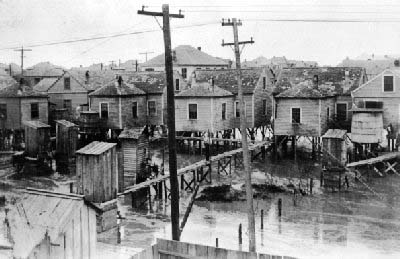|
 |
| Image courtesy of
Ellen Beasley - Galveston houses lifted in preparation
for landfill |

The Engines of Our Ingenuity is Copyright ©
1988-1997 by John H. Lienhard.
We Houstonians like to run down to Galveston
for seafood, for museums, or just to see ships and the Gulf. It's a
nice town. Yet in 1900 Galveston's citizens seriously considered
walking away from it -- letting it revert to a swamp. Many did leave.
The Galveston storm was the worst natural disaster America ever
suffered. Over 6000 people died. The way the city finally responded to
that horror forms one of the great American legends.
Galveston is a long island running west to east. It tilts slightly
to the northeast. On the north is a protected harbor. The south side
faces the Gulf of Mexico. The 19th-century city lay on the east end.
Its highest point was nine feet above sea level. Its mean elevation
was only five feet.
The city was flooded repeatedly down through the 19th century. In
1886 a commission talked about building a wall against the sea, but
they rejected the idea. It would cost too much. Now Galveston had seen
just how bad a hurricane could be. Citizens knew they'd have to either
give up their city or protect it.
So by a ratio of 150 to 1 the people who could vote decided to
undertake a wild engineering scheme. They would build a great dam, a
Sea Wall along the south Gulf coast. It'd be 17 feet high and 3 miles
long with a skirt of protective granite rip-rap. But the Sea Wall was
a piece of cake compared to what followed. Next they raised the whole
city. And this was the major city in Texas.
They slanted the ground so water that got over the Sea Wall could
run off toward the bay on the north. That meant raising the ground
almost to the lip of the Wall. Then they sloped it downward to eight
feet above sea level on the north.
To do that, they cut a canal into the city and began pumping in a
slurry of sand and salt water. The water ran off and left sand behind.
Homeowners had to lift their houses up on stilts so the slurry could
fill in under them.
It took 300 jacks to lift the big brick Moody mansion. It took 700
jacks to lift St. Patrick's church. Of course there was a component of
brutality in all that. Some homeowners couldn't afford the raising.
Some had to sacrifice the bottom floor of their houses. Some had to
abandon their homes entirely.
The work went on in sections for seven years. In 1915 the new city
they'd built suffered its first test. A storm every bit as bad as the
1900 hurricane hit Galveston and caused only eight deaths. Since then
they've extended the Wall and filled in more land. No one at all died
in hurricanes Carla and Alicia.
And, today, the very presence of Galveston is one of the great joys
of living in Texas.
I'm John Lienhard, at the University of Houston, where we're
interested in the way inventive minds work.
|
